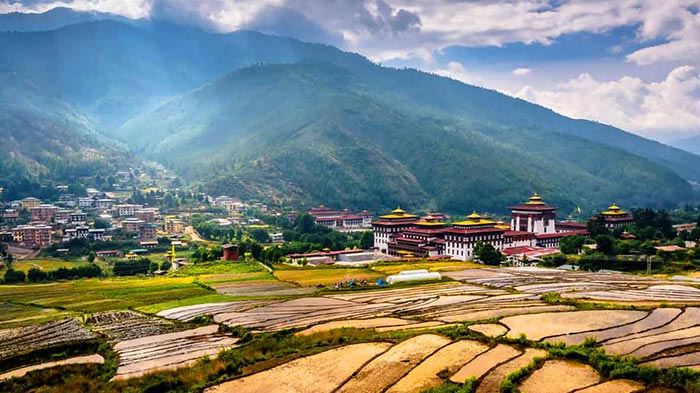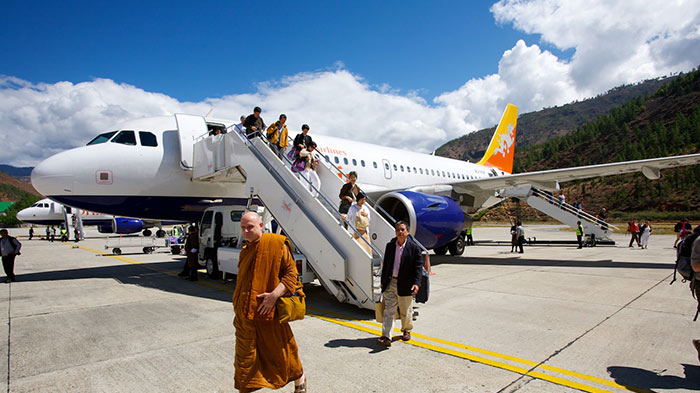
Where Is Bhutan Located?
Lying between China and India, bordering with Tibet across the Himalayas, Bhutan is a landlocked country in South Asia that is a premier destination for high-value tourism. Sitting on the southern edge of the Tibetan Plateau, this once-isolated nation, officially known as the Kingdom of Bhutan, has endured as an independent nation for centuries and is the second least populated country in the world.
While Tibet lies on its northern border, India spreads around its other three sides, with the Indian state of Sikkim to the west, Arunachal Pradesh to the east, and Assam State to the south. Bhutan, known as the “Land of the Thunder Dragon”, is smaller in size than Switzerland, yet has never been colonized by the massive nations that surround it. Fiercely guarding their traditional ways, the Bhutanese people live in a philosophy of “Gross National Happiness”, where both education and healthcare are provided for by the government, courtesy of its unique tourism industry.
A largely Buddhist nation, the country is led by its 5th Dragon King, Jigme Khesar Namgyel Wangchuk, the National Assembly government, and its religious leader, the Zhabdrung Rinpoche. A beautiful country with a landscape that ranges from high Himalayan mountains and alpine forests to lush sub-tropical plains and jungles, Bhutan is a country that prides itself on its environmental policies, and has the lowest carbon footprint of any country in the world. So low, in fact, that it actually converts more carbon that the kingdom produces.
Bhutan is the least corrupt country in Asia, and ranks top in Asia for economic freedom and second in per-capita income. However, the country is still one of the least developed countries in Asia, despite having one of the highest average incomes per head. And there is a reason for this. Bhutan’s environmental policies ensure that, by law, at least 60 percent of the country must remain forested for future generations. This massive ecological policy means that huge parts of the country are kept in their natural form, and are amazing places for trekking through the wild forests and primeval woodlands.
Brief History of Bhutan
The area inhabited now by Bhutan has been a site of human settlement since around 2,000BC, with archaeological remains found in the region. These local tribes persisted in the area for centuries, until the introduction of Buddhism to Bhutan in the 7th century. It was the first Zhabdrung Rinpoche, Ngawang Namgyal, that unified the tribes into one country in the mid-17th century after defeating three Tibetan invasions and established himself as overall ruler of the country. The rule was split between the civil and religious leaders, and it was not until the rise of the House of Wangchuk that the country elected a hereditary ruler, who took control of the former Druk Desi civil administration. The hereditary penlop (governor), Ugyen Wangchuk, of the Trongsa District, began his consolidation of power in 1885, and was officially installed as the Druk Gyalpo (Dragon King) in December 1907.
 Panarama of the capital of Bhutan - Thimphu
Panarama of the capital of Bhutan - Thimphu
After signing a treaty with the British Imperial forces in India in 1910, it was agreed that the British in India would not interfere in the internal affairs of Bhutan, and in 1947, when India gained its independence from the British Empire, Bhutan was recognized by them as a sovereign nation. By 1952, Bhutan has begun to emerge from its centuries-old isolation with a program of development, and the National Assembly, Royal Bhutanese Army, and the Royal Court of Justice were formed. In 1971, Bhutan became a member state of the United Nations, and a year later the fourth Dragon King ascended the throne aged just 16. It was this fourth king that initiated the philosophy of Gross National Happiness, over the western ideal of Gross National Product, and in 2006, satisfied that his work on education, health, decentralized governance, hydroelectric power, and environmental tourism was well under way, he abdicated in favor of his son, now the fifth Dragon King of Bhutan.
Tourism in Bhutan
Tourism in Bhutan is unique in many ways, most of which are dedicated to sustainable and environmental tourism. Eco-tourism is prevalent in a big way in Bhutan, as the government aims to ensure that the country’s natural forest environment is protected for future generations. Tourism in Bhutan caters to around 140,000 foreign visitors every year, which is increasing as the kingdom be comes more popular, and almost 21,000 people work in the tourist industry.
 Tourists to Bhutan can enjoy their holidays without the crowds
Tourists to Bhutan can enjoy their holidays without the crowds
Bhutan tourism is aimed at the high-value market, and the government has imposed a daily fee that covers the cost of the holiday in Bhutan. Known as the Minimum Daily Package, tourists are required to pay a minimum fee of USD 250 per day for their vacation. This amount covers the tourist’s hotel accommodation, food, guide, driver, and private vehicle, as well as other nominal fees. A portion of the Minimum Daily Package fee also goes to help alleviate poverty in the country by funding free schooling and healthcare. Moreover, with its policy of High Value, Low Impact tourism, only a certain number of tourists are allowed into the country at any given time, which prevents the kingdom from being overwhelmed with tourists that can damage the environment and alter the character of the kingdom. This means that tourists to Bhutan can enjoy their holidays without the crowds and get the most out of their trip.
While there are no UNESCO World Heritage sites in Bhutan as yet, there are literally hundreds of places of interest to visit around the country. From the ancient ruins of Drukgyel Dzong and the amazing Bumdeling Wildlife Sanctuary to the Jigme Dorji National Park and the world-renowned Taktsang Monastery, built on the side of a cliff over 300 meters above the Paro Valley.
Bhutan is also well known for its adventure trekking and hiking, of which the most popular are the Jhomolhari Base Camp Trek, Snowman Trek, and Masagang Trek. With its northern border in the high Himalayan Mountain Range, Bhutan has several mountains that stand over 7,000 meters tall. The highest mountain in Bhutan is the Gangkhar Puensum, which stands at 7,570 meters above sea level, and which is suspected to be the highest unclimbed mountain in the world. Click here to know more about Bhutan trekking tours
Travel to Bhutan
Getting to Bhutan requires travelers to first contact a registered Bhutanese tour operator or their international agents. Travel to Bhutan is not permitted without being on an organized tour by one of the few registered tour operators approved by the government, and even the visa is not available to those without a booked tour. Obtaining a visa for Bhutan can only be done by the tour operator, who makes the application on your behalf once you have booked a tour through them. The tour operator will work out the itinerary with you, advising on the best places to visit and taking your ideas to make you a customized tour of the kingdom. Once your itinerary has been completed and you have booked the tour, the tour operator will require a photocopy of your passport in order to apply for the visa and other travel permits. Once the visa is approved, the tour operator will forward the visa clearance letter, which will also be sent to the immigration control points at Paro Airport and the land border crossing points. On your arrival at Paro Airport, you will need to show the clearance letter to the immigration officials, who will stamp the visa into your passport.
 Paro International Airport
Paro International Airport
Getting to Bhutan from most countries around the world requires a connecting flight via one of five locations in Asia. Bhutan has one international airport, at Paro, and has two airlines of its own, Druk Air and Bhutan Airlines. Only these two airlines are permitted to run flights in and out of the kingdom, and those flights are between Paro and Thailand, India, Nepal, Singapore, and Indonesia (seasonal). All visitors from around the world must travel through one of those five countries in order to get the connecting flight to Bhutan. Airports can be found in Thailand at Bangkok, in Indonesia at Jakarta, in Nepal at Kathmandu, and in India at Delhi, Kolkata, Gaya, Bagdogra, Dhaka, Gelephu, Guwahati, and Mumbai (seasonal). If you are traveling to Bhutan, then Singapore or Nepal are the most popular airports for travelers from outside Asia, and flights to Bhutan run twice a week from most airports. Know more about how to get to Bhutan from Singapore and how to get to Bhutan from Nepal
Paro airport has an unusual and interesting history. While now it is more of a modern airport, when flights first began from Bhutan to Kolkata and back in 1983, the airport consisted of an airstrip, a small, two-roomed control tower (that was not even a tower), and a lawn with park-type benches for the departure lounge. The runway was lengthened in 1990 to enable larger aircraft to land, increasing the number of tourists that could be brought in on every flight, and a hangar was constructed for the planes. However, it was not until 1999 that the single terminal for passengers was completed and opened to the public.
Paro also has a particular peculiarity for landing and takeoff. With the airport being in the midst of alpine hills and forests, and just below the lower mountains of the Himalayas, the pilots are unable to land using instruments alone. All flights have to make visual landings and take offs, which means that there are only a small handful of pilots in the world who are qualified to fly planes for the Bhutan airlines. The surrounding mountains reach as high as 5,500 meters, and the depth of the valley where the airport is situated and its location on the banks of the Paro Chhu River, make it one of the most challenging airports in the world to perform a landing at.

Energetic, responsible and reliable, Sonam is a guide with more than seven years experience informing visitors about heritage sites and attractions places in Tibet.


.jpg)



0 Comment ON "Where Is Bhutan Located?"